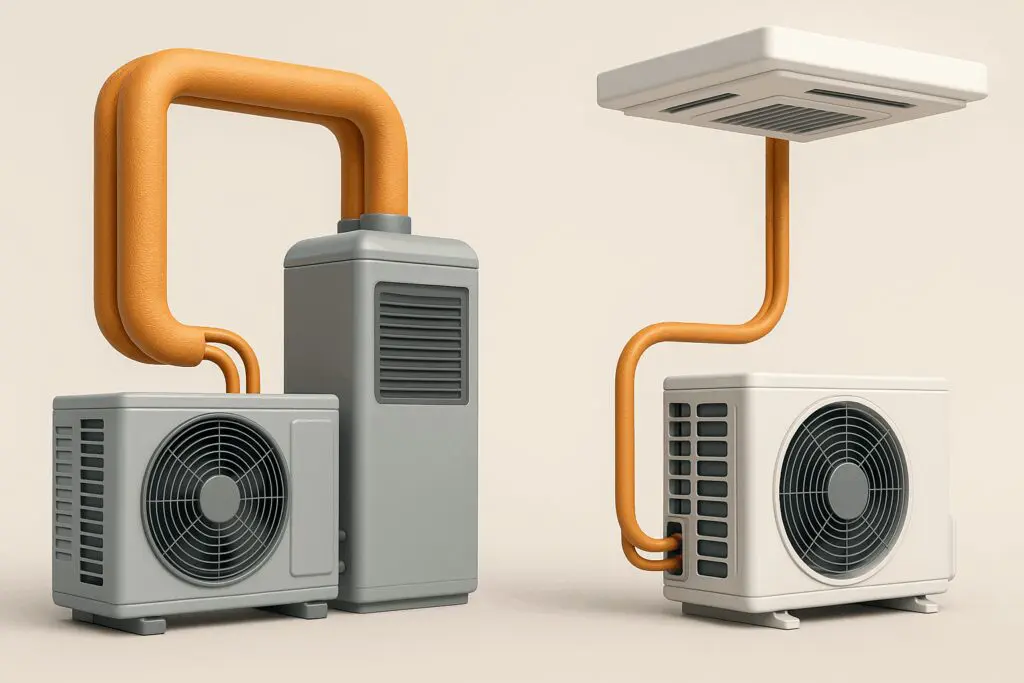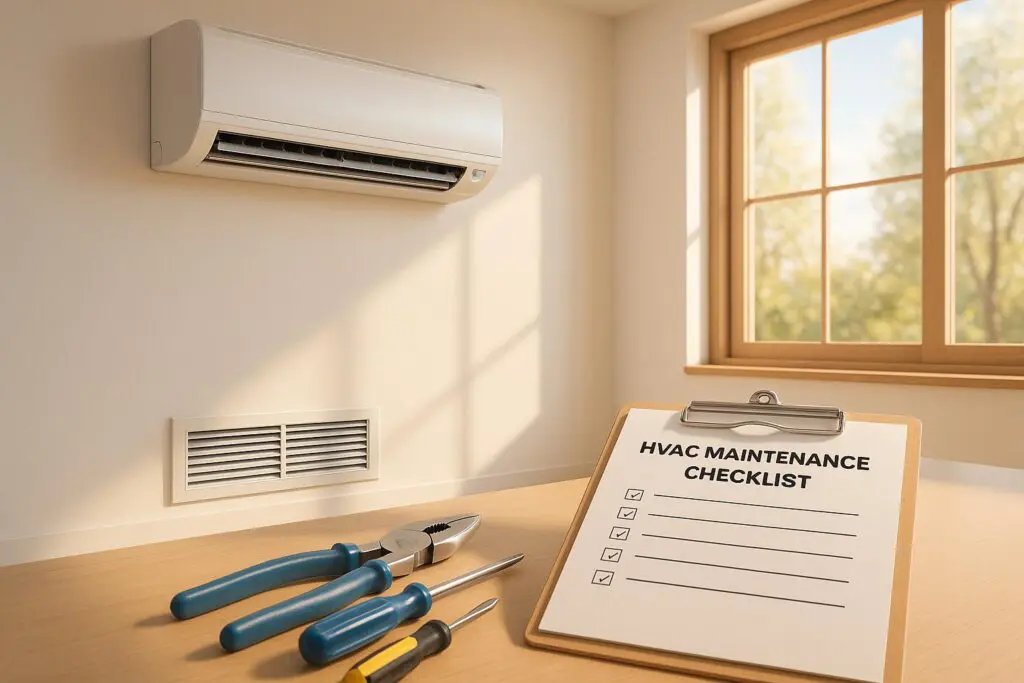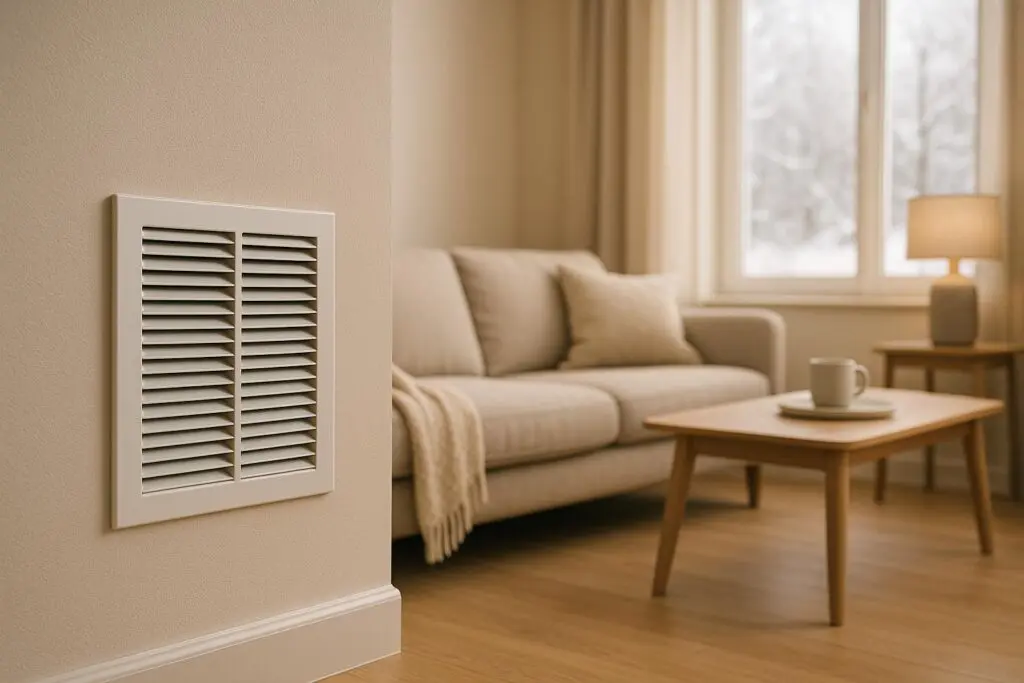If you’re researching alternatives to traditional central HVAC, especially for older homes, retrofits, or spaces without ductwork, you’ve probably encountered SpacePak (small duct, high velocity systems) and ductless mini-split systems. Both are viable options in many scenarios, but in the Chicago area, one often offers more long-term value, flexibility, and performance.
In this article, we’ll dive deep into how each system works, advantages and disadvantages, cost comparison, performance in Chicago’s climate, maintenance, and decision criteria — and make it clear why mini-splits are often the smarter choice for most homeowners. At the the end, we’ll also tell you how to get a quote from Eco Temp HVAC.
Learn More: Ductless Mini Split vs. Traditional Central HVAC: Pros and Cons
What Is SpacePak? What Is a Mini-Split?
Before comparing them head to head, let’s review how each works.
SpacePak (Small Duct High Velocity)
-
SpacePak is a brand and category of small duct, high velocity (SDHV) heating & cooling systems.
-
Instead of large rectangular ducts, SpacePak uses 2-inch pre-insulated flexible ducts that can be routed through wall cavities, floors, ceilings, etc.
-
The air handler (indoor unit) is compact and can fit in closets, crawlspaces, basements, or attics.
-
It uses a concept called aspiration: small high-speed air jets to mix and distribute air more evenly, eliminating “hot/cold spots.”
-
SpacePak also claims it can remove ~30% more humidity than conventional central systems, helping you set thermostat higher while maintaining comfort.
So, SpacePak is effectively a kind of “mini-duct” central system — you still have a central air handler, but the ductwork is much smaller and more flexible.
Ductless Mini-Splits
-
A ductless mini-split (or simply “mini-split”) consists of one outdoor compressor/condenser and one or more indoor air handling units (heads). No ductwork is required — refrigerant and control wiring connect the units.
-
Each indoor unit has its own fan, coil, and controls, so you can zone by room (or group of rooms).
-
Mini-splits often use inverter-driven compressors (variable speed), which modulate output to match demand, rather than simple on/off cycles.
-
They are efficient, quiet (since the loud compressor is outside), and well suited to retrofits or addition of conditioned spaces.
Considering Chicago’s Climate & Home Types
When making comparisons, it helps to narrow them to Chicago-specific factors.
Heating & Cooling Extremes in Chicago
-
Summers in Chicago can be hot and humid; winters can be brutally cold with subzero days. It’s vital that any HVAC/heat pump solution performs well year round.
-
Modern mini-splits are built to operate efficiently even in cold climates, making them viable as full heating systems.
-
SpacePak systems rely partly on the central heater or heat pump pairing; their low-duct design must be well matched to load.
Older Homes & Historic Properties
-
Many Chicago homes are historic, with plaster, masonry, no space for large ducts, and limited renovation tolerance.
-
SpacePak does well in those settings because its small tubes can hide behind walls and its vents are less visually intrusive.
-
But mini-splits require even less structural change (just small conduit penetrations), making them perhaps even more retrofit-friendly.
Efficiency & Energy Cost Benefits
-
In a city with sometimes high electrical rates and significant heating demand, every efficiency gain compounds.
-
Mini-splits’ lack of duct losses and their ability to run at partial load (thanks to inverter tech) yields consistent savings.
Maintenance & Support in Chicago
-
Because mini-splits are widely used, parts and service technicians are more common.
-
Niche systems like SpacePak might face longer lead times or fewer local experts over time.
Addressing FAQs & Objections (and Why Mini-Splits Win)
Let’s walk through common questions or objections — and equip you with answers that show the mini-split as the smart choice.
“What about humidity control? SpacePak removes 30% more humidity — isn’t that a big advantage?”
Yes, SpacePak markets that claim. But in actual performance, a properly sized mini-split system in Chicago’s humid summers can also maintain effective dehumidification. Because mini-splits run longer at lower power (vs. cycling), they can remove moisture efficiently over sustained runs. Moreover, you can pair mini-splits with additional dehumidification systems or choose models with enhanced moisture control features.
“Isn’t SpacePak quieter because the ducts are hidden?”
SpacePak systems use sound attenuators, but because they move air at high velocity through narrow ducts, there can be audible “whoosh” noise or pressure effects in tight runs. Meanwhile, mini-splits place the compressor outside and indoor units are engineered to be extremely quiet. In real homes, mini-splits often outperform in noise comfort.
“Will I need one unit per room with mini-splits, making it expensive and messy?”
Not necessarily. Many modern mini-split outdoor units support multi-zone setups, with several indoor heads on one condenser. You won’t need a separate compressor for each room unless your layout demands it. This modular flexibility lets you heat/cool rooms only when needed — saving energy and costs.
“What about lifespan and long-term reliability?”
SpacePak systems have a more limited adoption base, which may make repairs or replacement parts harder to source over time. Mini-splits are mainstream and have broad manufacturer support, making long-term service and replacement easier.
“What about architectural aesthetics? I don’t want wall-mounted units interfering with my décor.”
That’s a fair concern. But mini-splits now come in sleek designs, recessed ceiling cassette models, low-profile units, or floor consoles. With proper layout and aesthetic planning, they can look elegant. Meanwhile, SpacePak vents are very small and discreet — but the tradeoffs on maintenance, flexibility, and efficiency often tilt the balance toward mini-splits.
Recommendation: For Chicago, Most Homes Should Go Mini-Split
Putting all the pieces together:
-
Mini-splits offer greater flexibility, modular scalability, efficiency, and easier maintenance.
-
They perform well in Chicago’s summers and winters, thanks to modern heat pump capabilities.
-
Their parts and service support are far more abundant than niche systems like SpacePak.
-
Cost-wise, mini-splits typically have a better bottom-line when factoring in long-term maintenance, energy savings, and adaptability.
-
For older homes or tight spaces, the classic objection to “ducts” vanishes — you don’t need ducts at all with mini-splits.
That said, there may be rare architectural or historic preservation scenarios where SpacePak is still a viable option. But for the vast majority of homeowners in Chicago and suburbs, mini-split systems deliver the superior value.
Learn more: What is Ductless HVAC? Myths, Unique Needs, and FAQs
How to Choose (Checklist for Your Home)
Before making a decision, run through this checklist:
-
Load calculation — Do a Manual J or equivalent to size your heating/cooling needs.
-
Zoning needs — Do you want individual room control?
-
Existing architecture — Are there constraints on wall penetrations, ceiling space, crawlspaces?
-
Aesthetic preferences — How visible can indoor units be?
-
Budget & lifecycle cost — Consider not only installation but operating cost over 10–20 years.
-
Maintenance & support availability — Check local technician support for both systems in your area.
If you go through this and your home is reasonably modern, has good insulation, and you want energy savings + flexibility + quiet operation, mini-splits will very often come out ahead.
Get Your Mini-Split Quote Today (Chicago & Surrounding Areas)
If you’re ready to see how a high-quality mini-split system would perform in your home — with exact pricing, equipment options, and bespoke design — Eco Temp HVAC is ready to help.
We serve Chicago, Lemont, St Charles, and surrounding communities. Let us design a mini-split solution that beats SpacePak in comfort, cost, and flexibility — and helps you save energy year after year.












